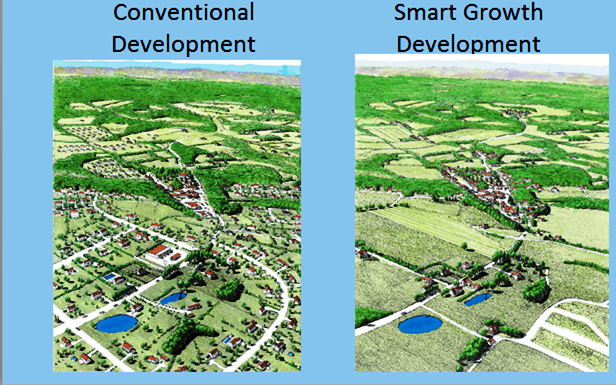Planning 101: Community Planning
Why plan?
The American Association of Planners describes the goal of planning as to maximize the health, safety, and economic well-being of all people living in our communities. This involves thinking about what type of development we want, where we want to locate development, how we can move around our community, how we can attract and retain thriving businesses, where we want to live, and opportunities for recreation. Planning helps create communities of lasting value.
Smart growth is a development pattern that promotes making efficient use of resources (land, infrastructure, financial), creating places that people enjoy for living, working and recreating, providing opportunities (economic, housing, transportation), and protecting community assets (natural and built).
- Smart Growth for Maine Communities (GrowSmart Maine)
- This is Smart Growth (Smart Growth Network)
- Smart Growth Self-Assessment for Rural Communities (EPA)
- Smart Growth Scorecards (EPA)
- Smart Growth Implementation Toolkit (Smart Growth America)
Maine’s Comprehensive Planning and Land Use Act (Growth Management Act)
Maine’s Comprehensive Planning and Land Use Act (Growth Management Act) was adopted in 1988 to help communities manage growth to build strong neighborhoods and town centers, while conserving rural areas, working landscapes, and natural resources. The Act established the Growth Management Program, and the current comprehensive plan requirement, building on a long history of promoting sound land use planning at the State level. Since the early 1900s the comprehensive plan has been the foundation of sound land use planning in Maine. And though it is not mandatory for Maine communities to have a comprehensive plan, it is a requirement for certain State grants and loans.
What is the Comprehensive Plan?
The comprehensive plan is the community’s blueprint for the future. It expresses a community’s collective vision, values, and goals, provides an action plan for implementing the vision, and serves as the legal basis for zoning, subdivision, and land use codes. It provides policy guidance on community elements such as growth and development, municipal services, infrastructure improvements, and other capital investments.
- Comprehensive Planning: A Manual for Maine Communities (Maine State Planning Office)
- Updating Your Comprehensive Plan: A Guide for Making Plan Updates Bolder and Smarter (Maine State Planning Office)
- The Municipal Plan – A Planning Manual (Vermont Department of Housing and Community Development)
- Sustaining Places: Best Practices for Comprehensive Plans (American Planning Association)
Engaging the Community
To ensure that a comprehensive plan articulates the community’s values and goals, it is essential to engage the community in the planning process. For the comprehensive plan to be inclusive of the diverse voices of the community, equity and inclusion must be at the center of engagement efforts.
- Local Outreach and Advocacy (GrowSmart Maine)
- Community Visioning Handbook (Maine State Planning Office)
- Rural America Placemaking Toolkit (Community & Economic Development Initiative of Kentucky)
- Engagement Toolbox (PennState Center for Economic and Community Development)
- A Quick Reference Guide for Hosting World Cafe (World Cafe Community Foundation)
- Just what is Charrette? (National Charrette Institute)
Developing the Comprehensive Plan
The development of the comprehensive plan is usually led by a designated Comprehensive Planning Committee or the town’s Planning Board and must be adopted by the municipality’s legislative body (the town meeting or town or city council). The Department of Agriculture, Conservation and Forestry (DACF), through the Municipal Planning Assistance Program (MPAP), provides guidance on developing a comprehensive plan to meet the goals and guidelines of Maine’s Growth Management Act. MPAP also provides planning resources and services:
- Upon request, MPAP will collect and share planning data useful to local comprehensive planning efforts.
- MPAP also has a handy Self-Assessment Checklist to help with the preparation of comprehensive plans.
Once a community has developed a comprehensive plan, it is then submitted to the MPAP for review for consistency with the Growth Management Act.
For more hands-on support, Maine’s Regional Planning Organizations provide general planning assistance to municipalities within their respective regions. This assistance will include answering general questions, advising on committee formation, explaining the Growth Management Act and the Comprehensive Plan Review Criteria Rule.
Implementation: Land Use Ordinances
Maine first enacted a requirement for comprehensive planning as the basis for zoning in 1943. The language was general, but the intent was clear: a “zoning ordinance shall be drafted as an integral part of a comprehensive plan for municipal development, and promotion of the health, safety and general welfare of the residents of the municipality.” Land use ordinances must be grounded in the comprehensive plan.
Zoning, subdivision, and other land use ordinances are the principal tools to implement comprehensive plans. A zoning ordinance consists of a written document and a map dividing the municipality into districts and specifies the types of activities that can occur in each district. Subdivision refers to the process of splitting up or assembling land for development. When updating the comprehensive plan, it is important to update land use ordinances as well to reflect the decisions and goals of the community.
If you’d like to download a printable PDF for your use, please fill out the short form below:

